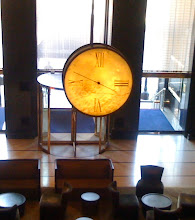The Dover second revised (1957) edition of Fads and Fallacies in the Name of Science was one of the first books to go on my "skeptics bookshelf," and it's still there, along with Gardner's
Science - Good, Bad and Bogus (Prometheus Books, 1981). Oh, and of course there's
The Annotated Alice (1961).
From the New York Times
obituary, by Douglas Martin:
"Martin Gardner is one of the great intellects produced in this country in the 20th century,” said Douglas Hofstadter, the cognitive scientist.
W. H. Auden, Arthur C. Clarke, Jacob Bronowski, Stephen Jay Gould and Carl Sagan were admirers of Mr. Gardner. Vladimir Nabokov mentioned him in his novel “Ada” as “an invented philosopher.” An asteroid is named for him.
Mr. Gardner responded that his life was not all that interesting, really. “It’s lived mainly inside my brain,” he told The Charlotte Observer in 1993.
...
Mr. Gardner, who lived in Hastings-on-Hudson, N.Y., for most of the years he wrote for Scientific American, resigned from the magazine in 1981. Two years later he began a column in Skeptical Inquirer, “Notes of a Fringe Watcher,” which he continued to write until 2002. He had already begun beating this drum, debunking psuedoscience, in his book “Fads and Fallacies in the Name of Science.” He helped found the Committee for the Scientific Investigation of Claims of the Paranormal.
In The New York Review of Books in 1982, Stephen Jay Gould, the evolutionary biologist, called Mr. Gardner “the single brightest beacon defending rationality and good science against the mysticism and anti-intellectualism that surround us.”
Michael Shermer, the publishing Editor of
Skeptic magazine, wrote an essay about Gardner in 2002 titled,
Hermits & Cranks.
In 1952 he expanded it into a book called In the Name of Science, with the descriptive subtitle “An entertaining survey of the high priests and cultists of science, past and present.” Published by Putnam, the book sold so poorly that it was quickly remaindered and lay dormant until 1957, when it was republished by Dover. It has come down to us as Fads and Fallacies in the Name of Science, which is still in print and is arguably the skeptic classic of the past half a century.
Thankfully, there has been some progress since Gardner offered his first criticisms of pseudoscience. Now largely antiquated are his chapters on believers in a flat earth, a hollow earth, Atlantis and Lemuria, Alfred William Lawson, Roger Babson, Trofim Lysenko, Wilhelm Reich and Alfred Korzybski. But disturbingly, a good two thirds of the book’s contents are relevant today, including Gardner’s discussions of homeopathy, naturopathy, osteopathy, iridiagnosis (reading the iris of the eye to determine bodily malfunctions), food faddists, cancer cures and other forms of medical quackery, Edgar Cayce, the Great Pyramid’s alleged mystical powers, handwriting analysis, ESP and PK (psychokinesis), reincarnation, dowsing rods, eccentric sexual theories, and theories of group racial differences.
...
What I find especially valuable about Gardner’s views are his insights into the differences between science and pseudoscience. On the one extreme we have ideas that are most certainly false, “such as the dianetic view that a one-day-old embryo can make sound recordings of its mother’s conversation.” In the borderlands between the two “are theories advanced as working hypotheses, but highly debatable because of the lack of sufficient data.” Of these Gardner selects a most propitious example: “the theory that the universe is expanding.” That theory would now fall at the other extreme end of the spectrum, where lie “theories almost certainly true, such as the belief that the earth is round or that men and beasts are distant cousins.”



